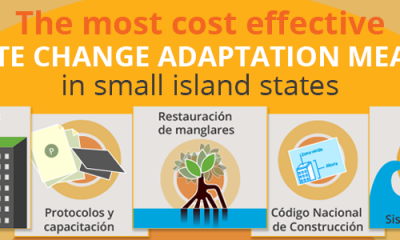Small developing island states (SDIS) are particularly vulnerable to the effects of climate change. For this reason, some island states of the Caribbean region such as Jamaica, Trinidad and Tobago, and Barbados can serve as laboratories where different adaptation measures to meet the challenges of climate change can be tested, assessing their cost-effectiveness.
A study on the economics of adaptation to climate change in Trinidad and Tobago has concluded that there are five adaptation measures considered of “no regret” –that is, low cost and high impact actions which will result in a better rate of return of the investments made by governments or private sector:
1. Creating a National Building Code: Developing a national policy framework with requirements and standards for the construction of new buildings allows architects and engineers to design buildings more resilient to climate change and able to withstand the impacts of extreme climate events such as tropical storms , earthquakes and other events that will become more frequent with climate change.
2. Mangrove Restoration: mangroves are ecosystems that provide great benefits to the environment. Mangroves absorb CO2 from the atmosphere, enhance biodiversity and protect act as a natural barrier, protecting coastlines from erosion. In addition, wood can be extracted from them and they also serve as fishing areas, contributing to the development of the local economy. Mangrove restoration is undoubtedly a low-cost, high-profit adaptation measure.
3. Weather Alert Systems: These systems collect climate information from the region disseminate it in real-time via the Internet, TV, radio, etc. to the local population, which can therefore prepare for the impacts of extreme climate events such as tropical storms, reducing or controlling the damage caused by these events.
4. Emergency protocols and training programs: The existing emergency protocols for extreme weather events would be standardized under a common framework so that they are easy to understand and accessible to the general public. In addition, training programs to educate and inform public officials on climate change and its effects would be designed, in order to train them on the correct management of emergency situations and the development of appropriate responses.
5. Installation of green areas on the roofs of buildings: gardens placed on top of buildings absorb CO2, while working as natural air conditioning by lowering the temperature inside the building and reducing water runoff in cities. This type of gardens also helps to raise awareness about climate change and about the need to promote green areas in the city.
Al these adaptation measures are part of the findings of a methodology Economy Climate Adaptation (ECA), which quantifies the economic costs involved in adapting to the impacts of climate change currently taking place in Latin America and the Caribbean. Trinidad and Tobago is the first country in the region that is applying this methodology through a project funded by the IDB and developed by Factor CO2, the University of the West Indies (UWI) and the Environmental Hydraulics Institute of Cantabria (IH Cantabria) . The study will be published here soon.
Read more about climate change in Trinidad and Tobago:
Who is going to pay the climate change piper in Trinidad and Tobago? By Gerard P. Alleng
Sustainable Action Plan for Port of Spain
Follow us on Twitter: @BIDcambioclima
* By Kepa Solaun, partner and CEO of Factor CO2
Philosopher, economist, lawyer, and Masters in Environmental Management. Kepa works as an advisor for several international organizations and his work currently focuses on developing climate change public policies, including the economics of climate change, adaptation to climate change and the quantification of climate change impacts. He also works as a professor in different programs related to Climate Change and Environmental Economics.


Leave a Reply